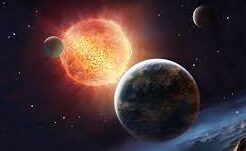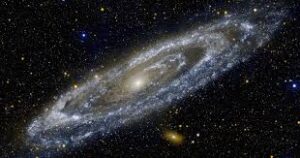
As astronomers delve deeper into the early history of the universe, they have uncovered a surprising number of gigantic black holes that appear to have matured much faster than previously thought possible.
Priyamvada Natarajan, a prominent astrophysicist at Yale University, approaches these black holes much like a biologist studying the life cycles of animals. She was among the first to analyze black holes as populations rather than isolated phenomena, investigating their taxonomy and evolution as one would study species in a rainforest. Natarajan has focused on understanding how these black holes are born and develop.
Traditionally, black holes are thought to form following the explosion of massive stars and then grow by accumulating surrounding gas. However, observations of supermassive black holes in the very early universe suggest that this might not be the full story. In 2006, Natarajan and her colleagues proposed a revolutionary idea: disks of gas could collapse directly into massive black holes without first forming stars. This theory offers an alternative pathway for the formation of what are known as “direct-collapse black holes.”
Recently, this idea gained significant support. Observations made by the James Webb Space Telescope (JWST) and the Chandra X-ray Observatory identified a distant, radiant black hole that seems to confirm Natarajan’s prediction. This discovery has provided substantial evidence for the existence of heavy black hole seeds that bypass the traditional stellar explosion route.
“It’s definitely a very strong case in favor of these heavy black hole seeds,” says Raffaella Schneider, an astrophysicist at Sapienza University of Rome. “[Natarajan] having proposed this idea really helped the community to enlarge our view on the different possibilities that can occur.”
In an interview with Scientific American, Natarajan discussed how these recent observations bolster her theory of direct-collapse black holes and what these findings reveal about the origins of these colossal entities.
What sparked your interest in studying black holes and their origins?
I’ve always been fascinated by the invisible entities in the universe. My work has primarily focused on understanding the fundamental nature of these dark components—dark matter, dark energy, and black holes. I find these objects incredibly seductive and enigmatic. They serve as a reminder of the limits of our knowledge and the points where the known laws of physics break down.
Over the past few decades, black holes have transitioned from being purely theoretical constructs to observable entities that are now central to our understanding of galaxy formation. The universe is teeming with black holes of various sizes, making them a crucial part of our cosmic inventory. Understanding their origins is a fundamental and open question in astrophysics.
What remains unknown about black hole formation?
Typically, black holes are born when stars die. When the most massive stars undergo gravitational collapse, the dense core they leave behind forms a black hole. This origin story is fairly well established.
But around two decades ago, as we started to look farther back into the universe with missions such as the Sloan Digital Sky Survey, we discovered a handful of very massive black holes—up to around a billion times the mass of the sun—when the universe was just one to two billion years old. Given the rate at which black holes are known to feed, there wasn’t enough time for the tiny seeds formed from the first stars exploding to grow into these behemoth black holes. Over the next few years, we realized these weren’t just rare anomalies; there was actually an entire population of supermassive black holes in the very early universe. And that’s when the real puzzle began.
Some researchers began exploring whether black holes could feed much faster than the established limit. Theoretically, there are mechanisms that could allow this, but we haven’t yet seen convincing observational evidence. So, I started considering the possibility of starting with larger black hole seeds. My team and I realized that if a gas disk is irradiated by stars from a nearby galaxy, it could bypass the star-formation process and collapse directly into a black hole. This direct-collapse black hole would be much larger at birth—between 1,000 and 100,000 times the mass of the sun. That black hole could then merge with a nearby galaxy and grow to the massive sizes we observe.
Reception by the Community
When we first proposed this idea, it faced significant pushback. Critics acknowledged the physics made sense but doubted whether the process could be efficient enough to occur in the universe. Observationally, we couldn’t access these early epochs of the universe at that time. To witness these initial seeds being formed, we needed to look back to the first billion years after the universe’s formation.
Role of JWST and Evidence Gathering
The James Webb Space Telescope (JWST) held the promise of providing the observational capabilities needed to test our theory, which kept us motivated. We brainstormed about potential signs of direct-collapse black holes and came up with a key idea. In nearby galaxies, the total mass of all the stars is usually 1,000 to 10,000 times the mass of the central black hole. However, in direct-collapse scenarios, the mass of the black hole could temporarily be comparable to the mass of the stars. This would result in an extremely bright, actively feeding black hole that outshines all the stars in the galaxy. Observing such a galaxy in both x-ray and infrared light would reveal distinct signatures of the overmassive black hole at its center.
Even with JWST and Chandra, we couldn’t see far enough back to directly witness early black hole seeds being formed. But I hypothesized that if we could find one of these galaxies behind a magnifying glass—a galaxy cluster rich in dark matter acting as a gravitational lens—we might have a chance. I had been mapping some of these gravitational lenses with the Hubble Space Telescope and suggested focusing our new telescopes on a particularly complex cluster called Abell 2744. I knew the dark matter map of this cluster inside and out. It was a long shot, but it was worth trying.
The Discovery
Early last year, I received an exciting call from my colleague, astrophysicist Akos Bogdan. He had been analyzing Chandra observations of galaxies behind the Abell 2744 lens and told me, “Are you sitting down? I think we found something.” Remarkably, the spectrum from one galaxy matched our prediction plots from 2017 of a hypothetical detection. It was astonishing—every predicted property checked out. This discovery provides compelling evidence that direct-collapse black holes do form in the early universe, moving the concept from speculation to reality.
Future Directions
While this discovery is significant, it doesn’t rule out other possible pathways for black hole seed formation. My next step is to investigate these alternative methods and identify their unique observational signatures. This opens a whole Pandora’s box of exciting questions.







